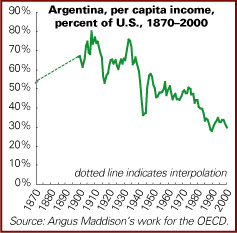Home
Mail Articles
Stats/current
Supplements
Subscriptions
Links
The following article appeared in Left
Business Observer #99, February 2002. It retains its copyright
and may not be reprinted or redistributed in any form - print,
electronic, facsimile, anything - without the permission of LBO.
COLLAPSING MODELS [2]: Argentina
The first collapsing model is Enron.
Though the orthodox now blame Argentina for bringing on its
own woes, not long ago it was the model of orthodoxy. The IMF's
1999 review of the country praised its "strong
investment-led growth," "commended the authorities for
their prudent economic management," and "noted the substantial
progress made by Argentina in recent years in structural reforms,
particularly in privatization, deregulation, pension reform."
Of particular relevance to the current crisis, the Fund "observed
that the currency convertibility plan has served Argentina well,
and continues to be an adequate framework for stable growth."
(More on this in a moment.) A year later, the Fund's annual review noted the strains from recession, but
continued to praise the authorities' prudent fiscal management
(i.e., budget cuts) and continuing structural reforms (i.e., privatization
and deregulation). The currency regime was praised again. The
banking system was praised for its admirable soundness. These
are the very same banks that Argentines spent the holiday season
lining up in front of, hoping to be reunited with their threatened
deposits.
Hardened money
Faced with an economic crisis in the late 1980s and early 1990s,
then-economy minister Dominigo Cavallo came up with
a magical solution to Argentina's woes - a currency board. This structure, which had
its origins in 19th century imperialism, fixed the value of the
Argentine peso to the U.S. dollar. No pesos could be issued unless
the central bank had dollars in reserve to back them up. This
prevented the central bank from printing currency, thereby putting
the brakes on a 3,000% inflation rate. It was also designed to
reassure foreign investors that the economy was in good hands.
came up with
a magical solution to Argentina's woes - a currency board. This structure, which had
its origins in 19th century imperialism, fixed the value of the
Argentine peso to the U.S. dollar. No pesos could be issued unless
the central bank had dollars in reserve to back them up. This
prevented the central bank from printing currency, thereby putting
the brakes on a 3,000% inflation rate. It was also designed to
reassure foreign investors that the economy was in good hands.
Reassured by the neocolonial monetary reform, foreign investors
poured money into Argentina, sparking a great boom. But those
capital inflows were mainly debt: banks, companies, and governments
borrowed aggressively. There was a brief interruption during the
Mexican
crisis of 1994-95, but the recession was mild, and the capital
inflows resumed. By the end of the decade, Argentina was borrowing
to cover its interest bills, and its debt burden had doubled.
Longer term, there's no way Argentina could live very long
under a dollar standard. An exchange rate is effectively a country's
price on world markets; weaker economies need currency devaluation
- an economy-wide price cut - to stay competitive. But Argentina
was denied that outlet. And it was also denied the freedom to
lower interest rates as the recession deepened; that outlet was
also blocked, since it was stuck with U.S. interest rates as its
standard.
But even in the boom, growth was never equitably distributed;
the World Bank conceded in its September 2000 brief on Argentina - one of its "most
active borrowers" - that "poverty levels have stubbornly
stayed high despite rapid economic growth." In the crisis
years of 1989 and 1990, 40% of the population was in poverty;
that fell to 17% a few years later, only to rise along with the
GDP, up to 25% in 1998. No more recent numbers are available,
but the recession has undoubtedly thrown millions more into poverty. Argentina, once a country where Brazilian-style
penury was rare, is now fully outfitted with soup kitchens.
The government responded to the recession by cutting the budget
to match falling revenues, a strategy that only worsened the slump.
No rich country would do anything like that to itself, but Argentina
had no choice if it wanted to keep capital coming in. The IMF
approved, and the capital kept flowing.
Prehistory
Which isn't to get nostalgic for what went before, in the crisis
years of the 1980s. Between 1980 and 1990, the economy shrank
14%, poverty rates rose from 8% to 40%, and inflation rose from
100% a year to over 3,000%. But the bad news goes back even further.
In the early 20th century, Argentina was one of the richest countries
in the world, with a per capita income 80% of U.S. levels. It
then began a long, though sometimes irregular, decline to around
30% today.
 There's a tendency among progressive
analysts to talk as if the time before 1980 or 1990 was a Golden
Age; in Argentina's case, the Golden Age was many decades longer
ago. And there's also a tendency to blame it all on the IMF. Surely
the IMF deserves considerable blame, but it's far from the whole
story; the IMF is the most visible agent of a larger system, and
the rest of the machinery deserves more attention than it gets.
There's a tendency among progressive
analysts to talk as if the time before 1980 or 1990 was a Golden
Age; in Argentina's case, the Golden Age was many decades longer
ago. And there's also a tendency to blame it all on the IMF. Surely
the IMF deserves considerable blame, but it's far from the whole
story; the IMF is the most visible agent of a larger system, and
the rest of the machinery deserves more attention than it gets.
So why did Argentina decline so? The story is complicated (and
will be the topic of an article in a forthcoming issue) [Alan
Cibils, "From Riches to Not Even Rags," LBO
#100], but the salient point is that its early wealth was based
on the export of grains and meats to Europe and the U.S. This
was not a sound foundation for a long-term prosperity. Over time,
it's become clear that there's never any dearth of competitors
when it comes to producing basic commodities, whether agricultural
or mineral. The country never developed its own industry or technology.
It was stuck in a subordinate role in the global economic hierarchy,
and fell ever-further behind. Successive governments tried aggressive
foreign borrowing and the printing of money to counter this downward
mobility, but it never worked. Cavallo's currency board, and his
courting of foreign investors, is only one chapter in this long
history of failure.
Constraints
Aside from its specific history, Argentina also suffers from
economic pathologies common to scores of other southern countries.
Economies need to invest a large part of what they produce in
order to grow. To produce more, they need, among other things,
technological innovation. But a country with heavy foreign debts,
like Argentina, sacrifices a large portion of its national product
to interest payments. And most of the world's technological know-how
is monopolized
by the rich countries, who have no interest in sharing their knowledge
with the less well off; in fact, the U.S. has been pushing for
ever-tighter restrictions on patents and copyrights in world trade
negotiations for the last 20 years. The path to a brighter future
is sealed off.
And there are good reasons why so many countries find themselves
so often in hock to the IMF. Countries run to the Fund because
they're chronically in deficit - importing more than they export
and shipping interest and dividends back to metropolitan creditors,
and so chronically in need of fresh finance.
Much of the world's population lives in countries with chronic
annual deficits, and large accumulations of debt to show for it.
For both Argentina and Latin America as a whole, debt (relative
to GDP) and the burden of servicing it (relative to national income)
is higher now than in all but the worst years of the 1980s crisis.
It was a crisis then because the solvency of the world's biggest
banks was threatened; though it still causes poverty and maldevelopment,
it's no longer considered a crisis now that the banks are safe.
Future
It's been inspiring to see thousands of Argentines in the streets,
forcing the resignations of four presidents in the last month
and spreading anxiety in Wall Street and Washington about the
incipient Latin repudiation of the whole neoliberal model that's dominated policymaking
over the last 20 years. Let's hope for more - and that it's contagious,
because a smallish country like Argentina can't do much on its
own. It's embedded in a political and economic system that virtually
dictates a subordinate role. Short of concerted action by a large
number of countries in the global South, it would be very hard
to challenge, much less overturn the hierarchy.
Despite making some rude noises, the new government of Argentina
appears to be quietly cutting a deal with the IMF; the cynical
thing would be to suspect that the rude noises are for domestic
consumption, and not to be taken seriously. Alas, again
Home Mail
Articles
Stats/current
Supplements
Subscriptions
Links
 came up with
a magical solution to Argentina's woes - a currency board. This structure, which had
its origins in 19th century imperialism, fixed the value of the
Argentine peso to the U.S. dollar. No pesos could be issued unless
the central bank had dollars in reserve to back them up. This
prevented the central bank from printing currency, thereby putting
the brakes on a 3,000% inflation rate. It was also designed to
reassure foreign investors that the economy was in good hands.
came up with
a magical solution to Argentina's woes - a currency board. This structure, which had
its origins in 19th century imperialism, fixed the value of the
Argentine peso to the U.S. dollar. No pesos could be issued unless
the central bank had dollars in reserve to back them up. This
prevented the central bank from printing currency, thereby putting
the brakes on a 3,000% inflation rate. It was also designed to
reassure foreign investors that the economy was in good hands. There's a tendency among progressive
analysts to talk as if the time before 1980 or 1990 was a Golden
Age; in Argentina's case, the Golden Age was many decades longer
ago. And there's also a tendency to blame it all on the IMF. Surely
the IMF deserves considerable blame, but it's far from the whole
story; the IMF is the most visible agent of a larger system, and
the rest of the machinery deserves more attention than it gets.
There's a tendency among progressive
analysts to talk as if the time before 1980 or 1990 was a Golden
Age; in Argentina's case, the Golden Age was many decades longer
ago. And there's also a tendency to blame it all on the IMF. Surely
the IMF deserves considerable blame, but it's far from the whole
story; the IMF is the most visible agent of a larger system, and
the rest of the machinery deserves more attention than it gets.